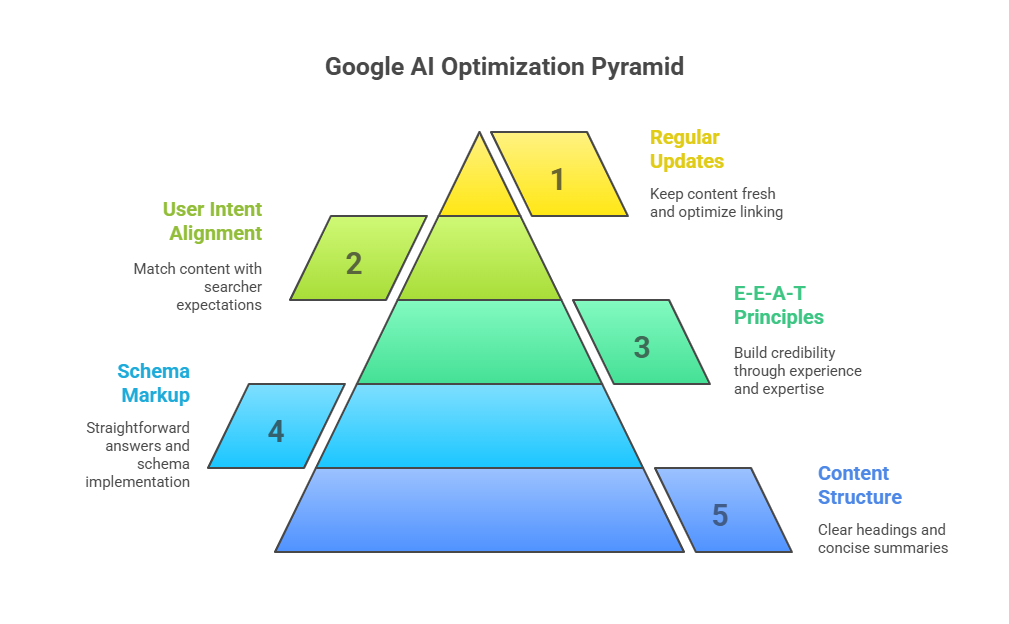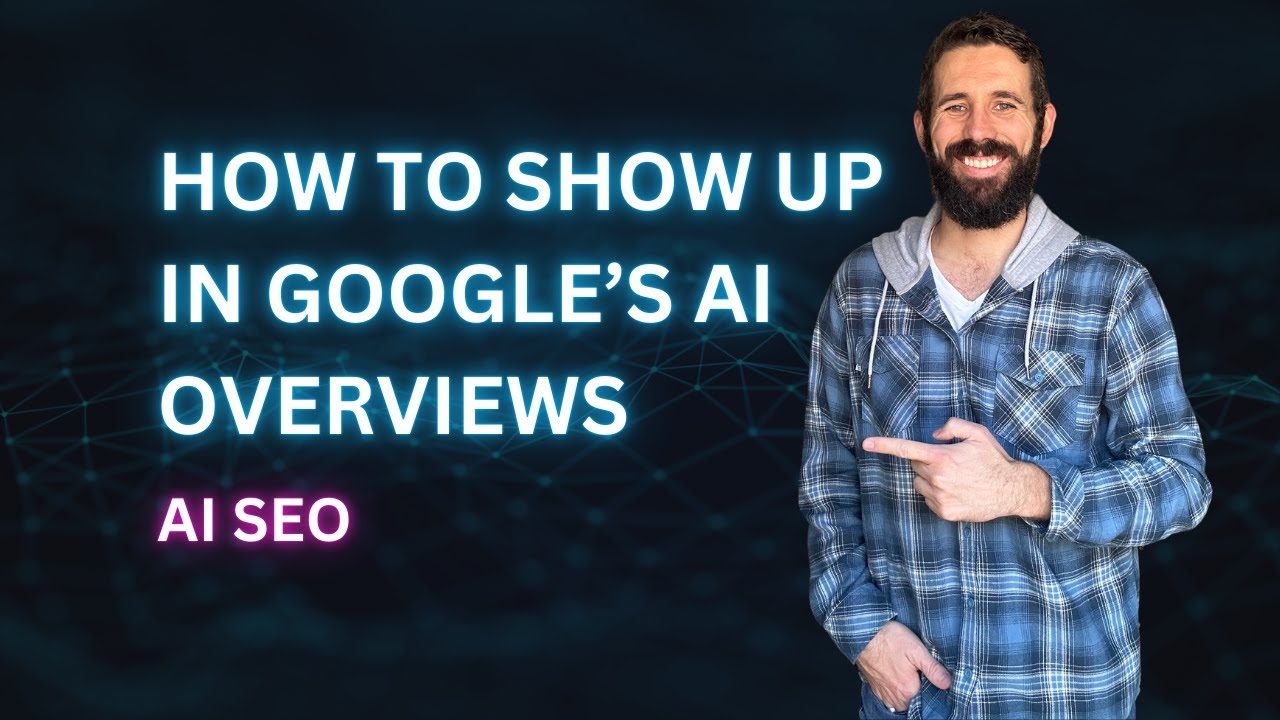Contents
In today’s evolving search landscape, Google’s AI Overviews are transforming how users receive information directly within search results. These AI-driven summaries provide concise answers sourced from authoritative content, making it essential for website owners and content creators to optimize their material accordingly. In this article, we will explore what Google’s AI Overviews are, how they work, and actionable strategies to help your content appear in these coveted AI snippets. Drawing on principles of SEO and E-E-A-T, this guide will equip you with the knowledge to boost your visibility in Google’s AI-powered search results.
What Are Google’s AI Overviews?
Google’s AI Overviews, often abbreviated as AIO, are succinct summaries presented at the very top of search results. When you search for a query, Google may display a summarized answer that quickly addresses your question without requiring you to click through multiple links. These overviews often include links to the original, authoritative sources, and sometimes visuals, blending traditional search with AI-driven content generation.
For example, if you search for a common question or topic, the AI Overview will pull relevant, concise information from indexed content that Google already has in its database. This content is prioritized based on structure, quality, and the credibility of the sources involved. Although AI Overviews do not appear for every search, their presence is growing as Google integrates more AI capabilities in response to competitive AI-powered search tools like ChatGPT and Bing’s AI search features.
While helpful for users seeking quick answers, AI Overviews can impact website traffic. Even if your website ranks first in search results and is cited in the AI Overview, users may not click through because their query is answered directly in the snippet. This shift makes it crucial to adapt your SEO strategy to optimize for AI Overviews, ensuring your brand remains visible and authoritative in this new format.
How Google’s AI Overview Works
Google’s AI Overview technology analyzes indexed content, focusing on structured, high-quality information that demonstrates expertise and trustworthiness. It then summarizes this content to provide an immediate, clear answer to the user’s question. The AI highlights sources with strong credibility signals, making it imperative that your website reflects these qualities to be featured.
Because AI Overviews summarize rather than replace content, they act as a new opportunity to show up in search results. However, they also present a challenge: balancing giving enough information to satisfy the AI’s summary needs without losing potential traffic. Understanding how to craft your content to fit these parameters is key to succeeding in the age of AI-enhanced search.
Strategies for Optimizing Content for Google AI Overviews
To increase the likelihood that your content will be included in Google’s AI Overviews, there are four main strategies to focus on:
- Restructure your content for AI Overviews
- Provide direct answers and use schema markup
- Establish credibility and trust with E-E-A-T principles
- Align your content with user intent
1. Structure Your Content for AI Overviews
Good content structure is foundational to both traditional SEO and AI optimization. Google’s AI relies on clear, organized information that it can easily parse and summarize. To achieve this:
- Use clear headings with proper HTML tags such as H1, H2, and H3 to break your content into logical sections.
- Incorporate bullet points and numbered lists to simplify complex information.
- Start each section with a concise summary that directly answers the question or topic introduced by the heading.
By structuring your content this way, you make it easier for AI to extract relevant pieces for its overview, increasing your chances of being featured.
2. Provide Direct Answers and Use Schema Markup
AI engines interact with users conversationally, so your content should mirror that style by including clear, direct answers to common questions. For example, if a user asks, “How do I optimize for AI Overviews?” your content should contain a brief, straightforward response followed by more detailed explanations.
Additionally, implementing schema markup—the structured data added to your website’s HTML—helps search engines better understand your content. Relevant schemas include:
- FAQ Schema for frequently asked questions
- HowTo Schema for instructional content
- Local Business Schema for location-specific information
Using these structured data formats improves your chances of being featured not only in traditional rich results but also in AI Overviews. You can verify your schema implementation using Google’s Rich Results Test Tool.
3. Establish Credibility and Trust with E-E-A-T Principles
Google values content that demonstrates Experience, Expertise, Authoritativeness, and Trustworthiness—collectively known as E-E-A-T. These factors are critical for appearing in AI Overviews because Google wants to source information from reputable, reliable sites.
Here’s how to build E-E-A-T on your site:
- Experience: Showcase your knowledge through high-quality blog posts, case studies, and testimonials.
- Expertise: Include author bios that highlight credentials and relevant background.
- Authoritativeness: Build backlinks from industry-relevant, high-authority domains to increase your site’s credibility.
- Trustworthiness: Ensure your website is secure with HTTPS and SSL certificates, is mobile-friendly, and functions smoothly.

By focusing on these aspects, you not only improve your traditional SEO but also position your content as a trustworthy source for AI-generated summaries.
4. Align Content with User Intent
Understanding and matching user intent is essential in both traditional SEO and AI optimization. It’s important to know what your audience is searching for and tailor your content accordingly.
Steps to align your content with user intent include:
- Conduct thorough keyword research using tools like Google Keyword Planner, SEMrush, or AI-powered keyword tools.
- Focus on long-tail keywords and natural, conversational phrasing that mimic how people speak, especially in voice search scenarios.
- Analyze the current search results for your target keywords to understand the type of content Google favors—whether it’s blog posts, product listings, or videos—and create content that fits that format.
For instance, users searching on Google might type “Italian restaurant near me,” but when interacting with AI assistants or chatbots, they tend to ask more conversational questions like “What’s the best Italian restaurant nearby?” Your content should reflect this conversational tone to improve AI SEO performance.
Additional Tips for Boosting Your AI Visibility
Beyond the core strategies, there are practical tips to keep your content competitive in AI-driven search:
- Refresh Content Regularly: AI Overviews favor current, relevant information. Updating older blog posts ensures your content remains fresh and authoritative.
- Test Queries in Google: Regularly search your target keywords to see if AI Overviews appear, what questions are being answered, and which sources are cited. Use these insights to fine-tune your content.
- Optimize Internal Linking: Create strong content clusters with a core pillar page supported by related blog posts that link back to it. This structure helps both users and search engines navigate your site effectively.
Recap: Key Strategies to Optimize for Google AI Overviews
To summarize, here are the essential strategies to help your content show up in Google’s AI Overviews:
- Structure Content for Clarity: Use clear headings, bullet points, and concise summaries to make your content easy to understand.
- Direct Answers and Schema Markup: Provide straightforward answers and implement relevant schema to enhance AI comprehension.
- Incorporate E-E-A-T Principles: Build credibility through experience, expertise, authority, and trustworthiness.
- Align Content with User Intent: Conduct keyword research and create conversational, user-focused content that matches searcher expectations.
- Regularly Update and Test: Keep content fresh, test AI queries, and optimize internal linking to maintain visibility.

These practices not only improve your chances of appearing in AI Overviews but also strengthen your overall SEO strategy in the age of AI-driven search engines.
Google’s AI Overviews represent a significant shift in how search results are presented and consumed. By understanding how these AI summaries work and adapting your content strategy accordingly, you can position your website to remain visible, trusted, and authoritative. Remember to focus on clear structure, direct answers, credibility, and user intent while staying updated on the evolving AI SEO landscape.
Embracing these strategies will help you not only rank well in traditional search results but also take advantage of AI-powered opportunities that are shaping the future of digital marketing.








